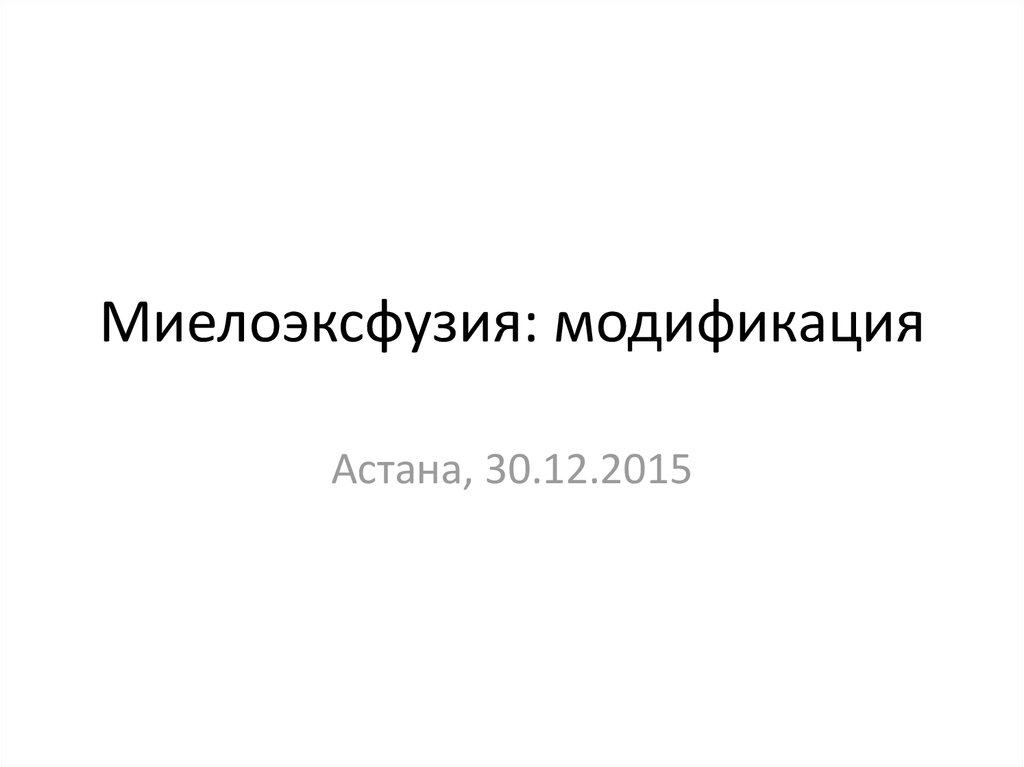Похожие презентации:
Миелоэксфузия
1. МИЕЛОЭКСФУЗИЯ
2.
3.
4.
5.
6.
7. Ромб Михаэлиса
8.
9.
10.
11.
12.
13.
14. РАСЧЕТЫ (гепарин)
• Общий объем костного мозга 15-18-20 мл/кгмассы тела реципиента;
• Рабочий раствор: Гепарин 25 000 Ед на 500 мл
физ. р-ра (концентрация 50 ед/мл)
• В шприц набирают 4 мл рабочего раствора
(=200 ед. гепарина);
• Конечная концентрация гепарина 10 ед на 1
мл костного мозга ;
• На одну процедуру уходит 2-3 флакона
рабочего раствора.
15. Количество мешков
m реципиента 70 кгV костного мозга = 18х70=1260 мл
Общий объем с учетом добавления
рефортана = 1575 мл (соотношение
рефортан: костный мозг = 1:4)
1575 мл = 3,5 гемакона по 450 мл = 4
гемакона
16. Количество пункций
• В один гемакон на 450 мл набирают 330 млкостно-мозговой взвеси = 15 шприцов по
22 мл (4 мл рабочего раствора + 18 мл
костного мозга)
17.
• Из 4-х проколов кожи с каждой стороны(итого 8 проколов)
• Из одного прокола кости максимум
набирают 2 раза на разной глубине;
• После каждого прокола кости меняют иглу
18.
19.
20.
21.
22.
23.
24.
25.
26.
27.
28. Миелоэксфузия: модификация
Астана, 30.12.201529.
30. Предпосылки
31.
32.
Representative images of CXCL12+ cells in bone marrow samples. Scale barindicates 25 μm. (a–d) CXCL12+ cells in control bone marrow. Arrowheads
indicate CXCL12+ cells (brown). CXCL12+ cells are located among
hematopoietic cells (a), around adipocytes (b), and in the perivascular area
together with capillaries (c) or sinusoids (d). Asterisk indicates the lumen of
the sinusoid. (e–g) CXCL12+ cells in myelodysplastic syndrome (MDS) (e),
acute myelogenous leukemia with myelodysplasia-related changes (AMLMRC) (f), and AML, not otherwise specified (AML-NOS) (g) bone marrows.
Note that CXCL12+ cells increased in MDS and AML-MRC bone marrow, but
were scarce in AML-NOS bone marrow.
33.
TRADITIONAL NEEDLES produce excessperipheral blood contamination,
diminishing cellular yield; thereby requiring
additional manipulation steps to achieve
the cellular demand necessary for most
clinical indications.
MARROW CELLUTION™ uses its
patent pending technology to
harvest high quality stem and
progenitor cells from various levels
within the marrow space, while
limiting peripheral blood
contamination.
34.
35.
Bone Marrow Transplant. 1992 Jun;9(6):467-70.
Bone marrow harvest for marrow transplantation: effect of multiple small (2 ml) or large (20 ml)
aspirates.
Bacigalupo A1, Tong J, Podesta M, Piaggio G, Figari O, Colombo P, Sogno G, Tedone E, Moro F, Van
Lint MT, et al.
Author information
Abstract
The aim of this study was to evaluate the yield of nucleated cells and CFU-GM and the T cell
composition in bone marrow harvested by means of multiple small (2 ml) or large (20 ml)
aspirations. Eleven marrow donors were studied: each donated 1000 ml of bone marrow in two
aliquots of 500 ml for an HLA identical sibling transplant. In six cases the first 500 ml were
harvested by means of multiple 2 ml aspirations (A) and the second 500 ml by means of 20 ml
aspirations (B). In five cases the opposite was done: 20 ml aspirates first (C) and 2 ml afterwards
(D). From each 500 ml aliquot a sample was taken for enumeration of nucleated cells and CD3+
lymphocytes and for CFU-GM growth. Small volume aspirations (groups A and D) yielded more
nucleated cells (p = 0.02), more CFU-GM (p = 0.03) and fewer CD3+ cells (p = 0.1) when compared
with large volume aspirations (groups B and C). This study shows that marrow harvesting by means
of multiple small volume aspirations minimizes the dilution with peripheral blood and results in
greater numbers of cells and hemopoietic progenitors.
36.
Biol Blood Marrow Transplant. 2011 Mar;17(3):351-5. doi: 10.1016/j.bbmt.2010.05.013. Epub 2010 May 27.
The effect of different harvest strategies on the nucleated cell yields of bone marrow collection.
Wang TF1, Chu SC, Chen SH, Huang KP, Su YC, Li DK, Shyr MH, Chang CY, Tsai HH, Kao RH.
Author information
Abstract
To improve bone marrow (BM) harvest of the volunteer donors in our institute, we changed from the single-hole
needle to the multi-side-hole needle after March 2002, and examined the midway total nucleated cell (TNC)
counts during collection after September 2004. The aims of this retrospective study were to evaluate
BM harvest yields obtained through different strategies and to examine the correlation between final and midway
BM harvests. The distribution of BM harvesting by different strategies was 235 donors with single-hole needles
(group A), 389 donors with 5-side-hole needles (group B), and 365 donors with 5-side-hole needles and midway
TNC counts (group C). The nucleated cell density of the collected BM was significantly improved by modifying
the harvest strategy (0.202 × 10(8)/mL in group A, 0.219 × 10(8)/mL in group B, and 0.250 × 10(8)/mL in group C; P
< .001). The percentage of unacceptable TNC dose (<2 × 10(8)/kg) was also decreased in all 3 groups (to 5.9%,
3.6%, and 0%, respectively; P < .001). Multiple regression analysis revealed that donor weight, white blood cell
count, and harvest strategy were positively correlated with BM TNC density (P < .001), whereas harvested BM
volume was negatively correlated with TNC density (P < .001). On linear regression analysis, highly significant
correlations were noted between midway and final TNC densities (r = 0.8774; P < .001) as well as between
harvested BM volume and TNC count (r = 0.7937; P < .001). Changing the harvesting needle and checking the
midway TNC count improved the harvest outcome.
To reduce the contamination of PB in the harvested BM, the volume of each
aspiration was restricted to 5 mL with the single-hole needle and 30 mL with
the multi–side-hole needle.




































 Медицина
Медицина








